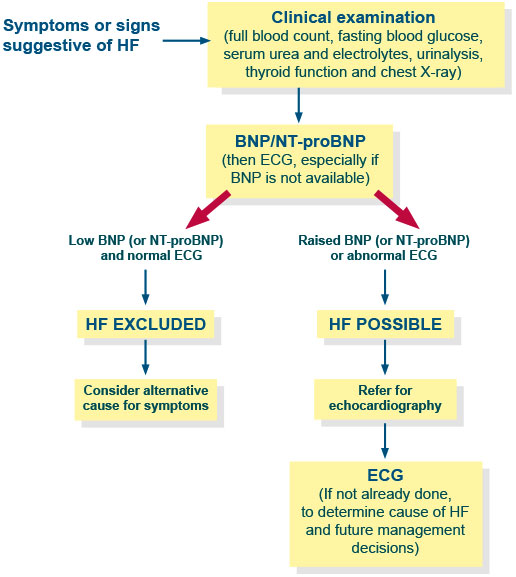Sandy manages to organise financial support through the Cash in Your Pocket scheme and travels to Aberdeen to meet with the cardiologist. The cardiologist assesses Sandy using an algorithm for diagnosing chronic heart failure.
SIGN 147 Management of chronic heart failure, 2016

Sandy undergoes the following investigations, in addition to the blood tests carried out by his GP:
Please enable JavaScript in your browser to see this interactive content.
Sandy is diagnosed with heart failure, NYHA II. After discussion with Sandy about his test results, the cardiologist refers him to the Heart Failure Nurse.
Algorithm for diagnosing chronic heart failure
- Symptoms or signs suggestive of HF
- Clinical examination (full blood count, fasting blood glucose, serum urea and electrolytes, urinalysis, thyroid function and chest X-ray)
- BNP/NT-proBNP (then ECG, especially if BNP is not available)
- Low BNP (or NT-proBNP) and normal ECG
- HF excluded
- Consider alternative cause for symptoms
- Raised BNP (or NT-proBNP) or abnormal ECG
- HF possible
- Refer for echocardiography
- ECG (if not already done, to determine cause of HF and future management decisions)
Based on the guidelines, Sandy undergoes the following tests
BNP Testing
B-type natriuretic peptide (BNP) an N terminal-pro-B-type natriuretic peptide
(NT-proBNP) are peptic hormones produced in the heart. Plasma BNP and
NT-proBNP are raised in patients with heart failure and concentrations tend to rise with deteriorating New York Heart Association (NYHA) class. Sandy is found to have a raised BNP level.
Echocardiogram
Echo can be very useful in diagnosing heart failure and in identifying its cause(s). It is recommended in any patient with a raised BNP or NT-proBNP in order to confirm the diagnosis and establish any cause. Sandy’s echo shows that he has heart failure secondary to Left Ventricular Systolic Dysfunction, with reduced Left Ventricular Ejection Fraction.
ECG
Patients with heart failure are very unlikely to have a normal ECG. It is, therefore, a good diagnostic test to confirm or refute heart failure when used in conjunction with other investigations. ECG abnormalities in heart failure tend to be non-specific. Sandy has already been diagnosed with atrial fibrillation and his ECG also shows signs of left ventricular hypertrophy.
Chest X-ray
Chest x-rays are normally used to detect or exclude any other conditions which maybe causing breathlessness, rather than to diagnose heart failure. It can, however, identify pulmonary congestion and oedema caused by heart failure. Cardiomegaly is a key chest x-ray finding in heart failure.
Psychological Assessment
Given the high incidence and prevalence of anxiety and depression in individuals with cardiac disease, it is important that all cardiac patients are screened for these. The cardiologist assesses Sandy using the Hospital Anxiety and Depression Scale (HADS). On assessment, Sandy does not show signs of either anxiety or depression.
Page last reviewed: 25 Sep 2020


